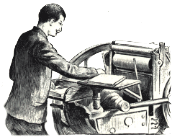|
Return to FIMP!
Return to |
at the Fiji Island Mermaid Press

Every linocut starts here - with a blank piece of linoleum and a pencil. With any type of original print, the artist creates a matrix - a printing element - which takes ink and transfers it to paper. The resulting print is the original artwork - the matrix is simply the vehicle with which the artwork is made. This sequence of photos demonstrates the creating of the matrix - the carved linoleum - and the printing of the artwork.
When I'm drawing on the block, I'm concentrating on the composition or placement of the elements in the design, and the proportions or skeletal structure of the objects in the image. Many of the ultimate decisions for how the image will appear are saved for when I'm cutting the block.
I've started to cut the block, using two gouges - a fine pointed V for sharp little lines, and a wider scoop to remove larger areas. Cutting a block is definitely a one-way street - once it's cut, it's gone! You've got to be pretty confident about what you want.
It's a unique way to make an image, in that your visual vocabulary is limited to strictly black and white - none of the greys that can be achieved with a pencil are possible. I mentioned above that many of the crucial decisions about the image are made while cutting the block - maybe here you can see why. Without a range of values, the direction of your cuts, their distance from one another, and the width of the lines becomes extremely important. I enjoy the challenge of working quite small, as it magnifies and celebrates the inherent difficulties of this form of image-making.
Once the block is cut, you're ready to print. A template is made, to guide the placement of paper and block on the press, and thick archival printmaking paper is torn (torn, not cut!) to size for the finished artwork.
A slab of ink is rolled onto a glass slab, and the ink is then rolled onto the block. One of the many variables in printing is the amount of ink that is applied to the block - too much or too little will both result in ruined prints.
The template is placed on the pressbed, ready for the block and the paper.
The inked block is transferred to the template, then the printing paper is laid on top of the block. Any shift of the paper at this point will botch the print - steady hands!
Here's the really exciting moment in the process - the pulling of the print! The inked block and the paper has been rolled through the press. The paper is carefully pulled from the block, and the artist gets his first look at the finished print.
Here you see the print and the block side by side. You'll notice that the artwork is a mirror image of the block. Eventually it becomes second nature for printmakers to think in reverse - especially if text is involved!
And, having pulled the print, the block is reinked, to be printed again. Each print that is deemed to be perfect by the artist is an original - it is not reproducing an image made in another medium, but IS the original image. Once the edition is printed, the block is discarded, having accomplished its purpose.
|













